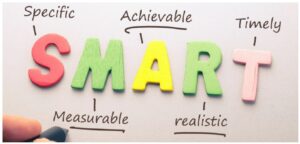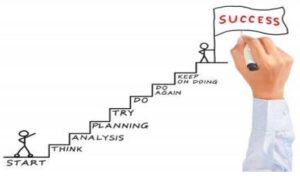How To Set And Achieve Goals For Peak Performance

Introduction:
Setting and achieving goals is an important aspect of peak performance, whether it be in sports, business, or personal development. The science of goal-setting has been extensively studied, and research has shown that setting specific, measurable, achievable, relevant, and time-bound (SMART) goals increases the likelihood of success.
For instance, I had always dreamed of becoming a civil servant, and passing the preliminary examination was just the first step towards achieving my goal. However, I only had four months to prepare for the mains examination, which seemed daunting given the vast syllabus that needed to be covered.
To tackle this challenge, I decided to set daily, weekly, and monthly goals for myself. I knew that I needed to be disciplined and consistent with my efforts if I wanted to succeed. I also divided my day into three four-hourly sessions, one for General Studies, one for Agriculture, and one for Botany, which were my two optional subjects.
Despite the overwhelming amount of material, I had to cover, I remained unfocused on my goals and persevered through the challenges. I made sure to use every available resource, including textbooks, study materials, and the university library to make the most of my preparation time.
As the exam approached, I reserved the last month for revision and mock tests. I knew that this was a critical period, and I couldn’t afford to waste any time. I studied previous years’ question papers and simulated test environments to prepare myself for the actual exam.
In the end, my hard work paid off. I cleared the civil services examination with flying colours, and I realized that anything is possible with determination, discipline, and a clear plan of action. My success story has inspired many others to set their own goals and pursue their dreams with passion and commitment. So let’s explore the science of goal-setting and the practical strategies for setting and achieving goals to optimize performance.
The Science of Goal-Setting

The Importance of Goal-Setting for Peak Performance
Goal-setting is a powerful tool for achieving peak performance. Research has shown that setting goals can enhance motivation, increase effort, and improve performance. Goals provide individuals with a clear direction and a sense of purpose, allowing them to focus their attention and effort on the task at hand.
The SMART Model of Goal-Setting
The SMART model of goal-setting is a popular framework for setting goals. SMART goals are specific, measurable, achievable, relevant, and time-bound. Specific goals are clear and well-defined, measurable goals can be quantified and tracked, achievable goals are realistic and attainable, relevant goals align with personal values and priorities, and time-bound goals have a specific deadline for completion.
Goal-Setting Theory
Goal-setting theory suggests that setting specific and challenging goals can enhance performance by providing individuals with a clear target to strive for. The theory proposes that goals should be challenging but attainable, and that feedback and support are critical for goal attainment.
The Role of Self-Efficacy in Goal-Setting
Self-efficacy, or an individual’s belief in their ability to succeed, is an important factor in goal-setting. Research has shown that individuals with higher levels of self-efficacy are more likely to set and achieve challenging goals.

Strategies for Goal-Setting and Goal Achievement
Developing a Goal-Setting Action Plan
Developing an action plan is an essential component of goal-setting. An action plan outlines the steps needed to achieve a goal, including specific actions, timelines, and resources needed.
Visualizing Success
Visualizing success is a powerful tool for goal-setting. Visualization involves imagining oneself successfully achieving a goal, including the emotions and sensations associated with success.
Using Positive Self-Talk
Positive self-talk can be used to enhance motivation and confidence in goal-setting. Positive self-talk involves using positive affirmations and statements to encourage oneself and build confidence.
Seeking Social Support
Social support can be a valuable resource in goal-setting. Seeking support from friends, family, or colleagues can provide encouragement, feedback, and accountability.
Monitoring Progress
Monitoring progress is a critical component of goal-setting. Regularly tracking progress can help individuals stay on track, adjust their action plans as needed, and celebrate small successes along the way.
Examples of Goal-Setting for Peak Performance
Goal-Setting in Sports
Goal-setting is commonly used in sports to enhance performance. Athletes may set specific goals related to performance metrics such as time, distance, speed or physical fitness.
Shah Rukh Khan, also known as the “King of Bollywood,” set a peak performance goal to improve his physical fitness and transform his body for his role in the movie “Happy New Year.” His goal was to lose weight and build muscle to portray a character who was a former athlete.

To achieve this goal, Khan used the SMART goal-setting process. He made his goal Specific by identifying the amount of weight he wanted to lose and the muscle he wanted to gain. He made it Measurable by setting a deadline for his goal and tracking his progress using body measurements and fitness tests. He made it Achievable by working with a team of personal trainers, nutritionists, and fitness experts to develop a customized workout and diet plan. He made it Relevant by tying his goal to his professional aspirations as an actor. Finally, he made it Time-bound by setting a deadline for his transformation to coincide with the filming schedule of the movie.
Khan documented his journey on social media, sharing updates on his progress and motivating his fans to prioritize their health and fitness. He eventually achieved his goal, losing several pounds of weight and gaining muscle mass in the process. His physical transformation was widely praised by audiences and critics alike, and he continues to inspire others to set and achieve their peak performance goals.
Goal-Setting in Business
Goal-setting is a common practice in business to enhance performance and productivity. Businesses may set specific goals related to sales targets, customer satisfaction, or product development. Goal-setting can also be used to enhance employee motivation and engagement.
Goal-Setting in Personal Development
Goal-setting can be used in personal development as an effective tool to help individuals identify their objectives, create a plan of action, and track their progress towards achieving their desired outcomes. Setting goals can help individuals clarify their aspirations and provide motivation to work towards achieving them.
Here are some steps that individuals can take when setting goals for personal development:

Identify your long-term goals: Start by identifying your long-term aspirations, the things that you want to achieve over the next few years or even decades. These can be related to your career, personal life, relationships, health, or any other aspect of your life.
Break down your long-term goals into short-term objectives: Once you have identified your long-term goals, break them down into smaller, more manageable objectives that you can work on in the short term. This will make it easier to track your progress and stay motivated.
Make your goals specific and measurable: Ensure that your goals are specific and measurable so that you can track your progress towards achieving them. For example, if your goal is to lose weight, specify the amount of weight you want to lose and by what date.
Create an action plan: Develop a plan of action that outlines the steps you need to take to achieve your goals. This may include developing new habits, learning new skills, or seeking out support from others.
Track your progress: Regularly track your progress towards achieving your goals. This can help you stay motivated and identify any areas where you need to make adjustments to your plan of action.
Remember, goal-setting is not a one-time activity, but an ongoing process. As you achieve your goals, you can set new ones to continue your personal development journey.
Here are some additional tips to keep in mind when setting goals for personal development:
Set realistic goals: Ensure that your goals are realistic and achievable based on your current skills, resources, and circumstances. Setting unrealistic goals can lead to disappointment and discouragement.
Focus on the process, not just the outcome: While it’s important to have a clear outcome in mind, focusing solely on the result can be overwhelming. Focus on the process of achieving your goals and celebrate small victories along the way.
Be flexible: Life is unpredictable, and circumstances can change. Be open to adjusting your goals and plans as needed to stay on track.
Seek support: Personal development can be challenging, and having a support system can help you stay motivated and accountable. Consider seeking support from friends, family, a mentor, or a coach.
PEAK PERFORMANCE GOALS
Peak performance goals are designed to push individuals to reach their full potential in a particular area of their life. These goals are not just about achieving success, but also about continuous growth and improvement. They can be related to any aspect of life, including physical fitness, mental performance, career success, personal development, and relationships.

To set peak performance goals, it’s important to first identify your strengths and weaknesses in the area you want to improve. Next, consider what steps you need to take to achieve your desired outcome, and break down those steps into smaller, actionable goals. It’s also important to set a timeline for achieving your goals and to track your progress along the way.
Here are a few examples of peak performance goals:
Running a Marathon: A peak performance goal for a runner might be to complete a marathon within a specific time frame. To achieve this goal, they might break down their training into smaller goals, such as increasing their weekly mileage, improving their speed, and building their endurance.
Increasing Sales Performance: A sales professional might set a peak performance goal of increasing their monthly sales by a certain percentage. To achieve this goal, they might focus on developing their sales skills, building their network, and identifying growth opportunities.
Improving Mental Performance: An individual looking to improve their mental performance might set a peak performance goal of learning a new language or mastering a musical instrument. They could break down this goal into smaller, measurable steps, such as practising for a certain amount of time each day or completing a specific number of lessons.
Achieving a Health and Fitness Milestone: A peak performance goal for someone looking to improve their health and fitness might be to complete a certain number of push-ups or pull-ups or to run a certain distance without stopping. They might break down this goal into smaller goals, such as increasing the number of reps they can do each week or gradually increasing their running distance.
In conclusion, setting peak performance goals can help individuals push themselves to achieve their full potential in all aspects of life. By identifying specific, measurable targets and breaking them down into smaller, actionable steps, individuals can track their progress and continuously improve their performance over time.
In the finale, goal-setting is a valuable tool for peak performance. By identifying your aspirations, creating a plan of action, and tracking your progress, you can achieve your goals and continue to grow and develop as a person. Remember to set realistic goals, focus on the process, be flexible, and seek support when needed.
 Dr K. Jayanth Murali is a retired IPS officer and a Life Coach. He is the author of four books, including the best-selling 42 Mondays. He is passionate about painting, farming, and long-distance running. He has run several marathons and has two entries in the Asian book of Records in full and half marathon categories. He lives with his family in Chennai, India. When he is not running, he is either writing or chilling with a book.
Dr K. Jayanth Murali is a retired IPS officer and a Life Coach. He is the author of four books, including the best-selling 42 Mondays. He is passionate about painting, farming, and long-distance running. He has run several marathons and has two entries in the Asian book of Records in full and half marathon categories. He lives with his family in Chennai, India. When he is not running, he is either writing or chilling with a book.
